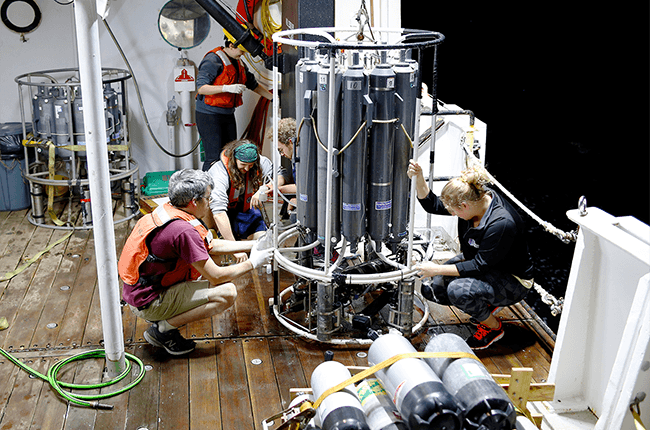Scientists now estimate that more than 13 trillion gallons of floodwater from Hurricane Harvey flowed into the Gulf of Mexico following the storm, and a team of researchers from Texas A&M University is trying to determine the impact on the Flower Garden Banks National Marine Sanctuary.
The team recently returned from a six-day trip to examine the massive plume of freshwater potentially threatening marine ecosystems in the Gulf and the salinity-sensitive coral reefs of the Flower Garden Banks National Marine Sanctuary. About 100 miles offshore of Galveston, the team discovered that salinity levels in the national marine sanctuary were normal; however, ongoing research was deemed necessary.
The influence of Harvey runoff was still seen along the coast near Galveston where salinity levels were low for this time of year, said Kathryn Shamberger, assistant professor in the Texas A&M University Department of Oceanography and Texas A&M Geochemical and Environmental Research Group (GERG) scientist, who was on the expedition.
Assessing the health of the reef
“We will now compare the water data we collected last week to data collected in 2016 to assess the health of the reef now,” Shamberger said.
The research team sailed on the R/V Point Sur and included Texas A&M Assistant Professor of Oceanography Jason Sylvan, Rice University Assistant Professor of Biosciences Adrienne Correa, Boston University Biologist Sarah Davies and University of Houston-Clear Lake Biologist Lory Santiago-Vazquez. The team expect to receive a one-year Rapid Research Response grant from the National Science Foundation (NSF) to support their work at the Flower Garden Banks.
Gulf researchers had cause for concern after Hurricane Harvey because of salinity data collected by buoys in the Texas Automated Buoy System (TABS), run by Texas A&M GERG. TABS network buoys monitor the waters off the Texas coast and relay real-time ocean data.
On Sept. 28, a buoy measured a 10 percent drop in salinity in the Flower Garden Banks coral reefs.
“The salinity at one buoy on the reef dropped from 36 to 32 Sept. 28, but it rebounded to 36 by Oct. 4, and it has been between 35 and 36 since then,” Correa said.
Shamberger and Sylvan also are working in collaboration with staff scientists from the National Oceanic and Atmospheric Administration’s Office of National Marine Sanctuaries to collect samples of water, microbes, sediment, corals and sponges to monitor the health of the reefs.
The impact of freshwater influx
“The Harvey freshwater had moved toward Corpus Christi and was northwest of the Flower Garden Banks when I was on the last cruise, which ended Oct. 1,” Shamberger said.
Flower Garden Banks, the only national marine sanctuary in the Gulf of Mexico, is one of 14 federally designated underwater areas protected by NOAA’s Office of National Marine Sanctuaries.
The team’s post-Harvey research at the reefs have roots in the April 2016 “Tax Day Floods” that also inundated parts of Houston.
“In late July 2016 there was a partial die-off on the East Flower Garden Bank,” Correa said. “We didn’t know it was happening until a recreational dive boat happened to go out there and see it. Because we didn’t know about the risk ahead of time, we couldn’t sample on a timeline that made it easy to figure out a mechanism for the die-off. With Harvey, we were able to catch the ‘before’ much better than we were in 2016.”
“Samples collected after the 2016 event revealed differential microbes in the water column near the reefs that experienced mortality compared to those who didn’t,” Sylvan said. He and his team are seeking to describe the water column microbial community in relation to Harvey to determine if this more recent freshwater runoff event had similar results to what happened in 2016.
“When people look at the impact of hurricanes on coral reefs, they often look at physical damage or breakage of reef frameworks by waves and storm surge,” Correa said. “Much less is known about the impacts of freshwater influx from the precipitation associated with a hurricane.”
###
Media contact: Leslie Lee, Communications Coordinator, College of Geosciences at Texas A&M at (979) 845-0910 or leslielee@tamu.edu






